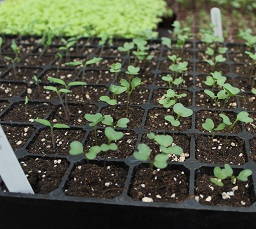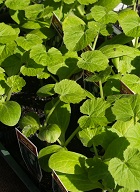Propagating Plants from seed
 With a little knowledge and the right equipment, it's easy to propagate plants from seed. Seed is generally the most straight forward method to propagate plants; but for commercial production it is not always the most appropriate. Your choice of propagation method should be determined by the type of plant you are propagating. For vegetables, annual flowers and some other plants, seed may be the ideal technique, but for others, a seedling does not produce a plant that is the same as it's parent (in which case other techniques need to be used).
With a little knowledge and the right equipment, it's easy to propagate plants from seed. Seed is generally the most straight forward method to propagate plants; but for commercial production it is not always the most appropriate. Your choice of propagation method should be determined by the type of plant you are propagating. For vegetables, annual flowers and some other plants, seed may be the ideal technique, but for others, a seedling does not produce a plant that is the same as it's parent (in which case other techniques need to be used).
Growing from seed is a good starting point for anyone new to propagation. You can take in the feeling of creating a plant from scratch and grow it up to flower or fruit. However, it doesn't always give the best plants. Hybrid plants or new varieties are best purchased from your local nursery as these plants don't reproduce the same as the original from seed.
To propagate most plants by seed first consider the following:
- seed must be alive but also matured if it is to germinate, hence it is best to harvest it or buy fresh stock.
- ensure you choose the right season to sow your seeds
- follow instructions to the letter to ensure good germination
- keep seeds and seedlings moist but not wet.
The Basic Steps
1. Materials and Equipment
Use equipment that is clean and free of any infectious diseases. If you are reusing old materials, sterilise them. (eg. Old pots, knives, secateurs etch should be washed with household bleach or a solution of pool chlorine).
2. Sow seeds
The seed tray or pot should be filled to just below the rim of the pot with good quality seed raising mixture that has been specially blended to improve germination. This should be lightly moistened and allowed to drain freely.
To make the necessary depression for the seeds you may either use a dibble to make small holes just deep and big enough for single seeds; or make a shallow furrow to sow seeds in a single line; or you may simply spread the seed evenly over the mix.
Ensure that the seeds are not too close to one another otherwise disease may be increased and separation of the seedlings may be difficult.
3. Cover seeds
It is important to cover the seeds with a fine layer of mixture to improve germination. As a general rule, seeds are covered to about twice their diameter with seed raising mix (alternatively, you could have made the holes and depressions this depth originally).
Some specialised plants require seeds planted on the surface or at a greater depth. For these plants follow the recommendations as stated on the back of the seed envelope.
Gently apply pressure so as to improve seed/mix contact to speed up germination. Gently water in.
 4. After care
4. After care
Position the seed tray or pot in a position where it will receive some light but not full sun. Deep shade should be avoided as it promotes poor development of the young seedlings. A greenhouse or cold frame is often used, particularly in cooler climates. Avoid positions where there are cold draughts; likelihood of being damaged by children, pets or wild animals; or positions where the tray or pot is subject to heavy rainfall and water droplet damage. Ensure seed tray is continually watered.
As seedlings appear continue watering and rotate trey if plants are bending due to inadequate light supply (even better, move plants to a sunnier position).
5. Seedlings
As they continue to grow you should give consideration to providing a weak soluble fertiliser to assist plant development. When they are past the two leaf stage (ie when more leaves are to develop) you can transplant the seedlings into their own growing on pots or directly into the ground (depending on the variety). Provide adequate moisture to promote growth and to minimise any shock during the transplanting process.
You may also be interested in....